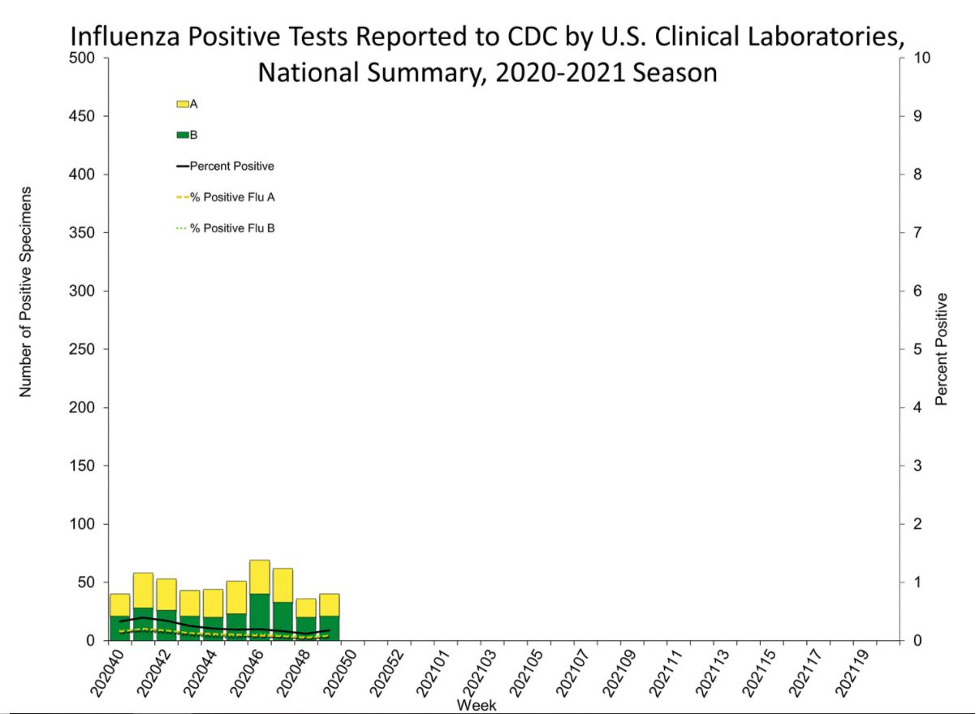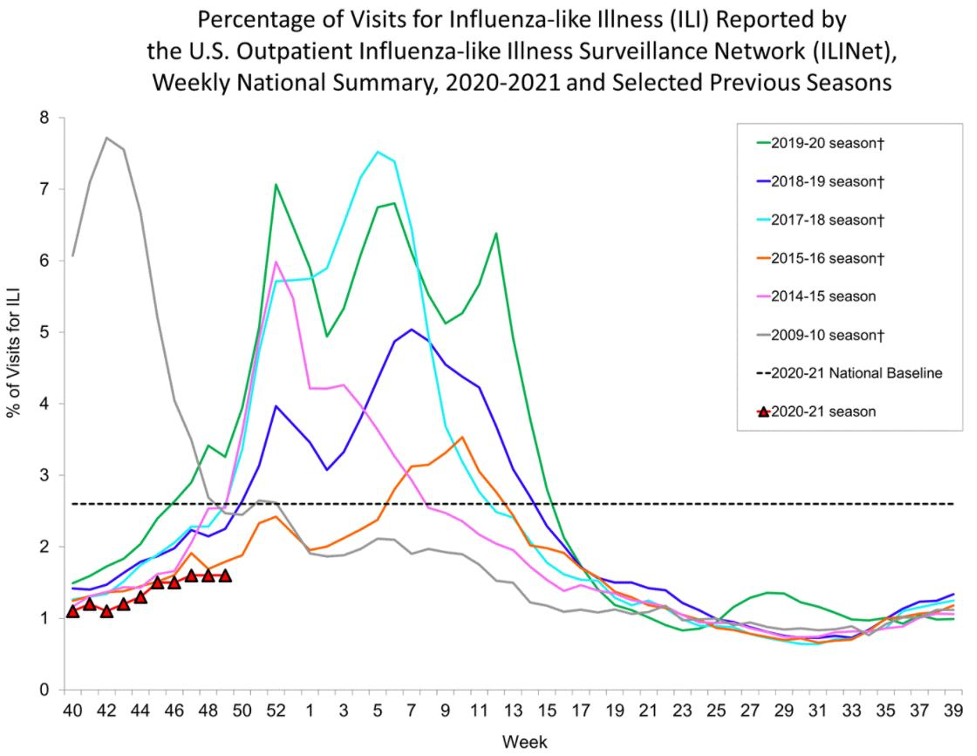Where has the seasonal influenza gone?
Recent data provided by the Centers for Disease Control and Prevention’s (CDC) Weekly U.S. Influenza Surveillance Report shows a remarkably low number of patients infected with the seasonal influenza this year.
According to the report, so far for the 2020-2021 flu season, only 496 people have tested positive for the influenza virus since September 27, 2020. That number is out of the 232,452 cumulative tests which have been performed, leaving the current percent of tests that come back positive at only 0.2%.

Photo Credit: CDC
Data for this article was taken only from reporting to the CDC by U.S. Clinical Laboratories, and excluded tests from Public Health Laboratories.
The drastic drop in this year’s seasonal influenza has led the CDC to state on its website, “Seasonal influenza activity in the United States remains lower than usual for this time of year.”
The CDC also notes that, “Influenza activity was low in the summer months and few specimens have tested positive in public health labs during recent weeks.”
This year’s low influenza activity is made starker by comparing it to data from previous years. During the 2019-2020 flu season, at this same time one year ago (Week 49), 15,027 people had tested positive for the flu. That year, 265,670 tests for the flu had been conducted at that point, making the positivity rate 5.7%.
The 496 flu cases from this year compared to the over 15,000 last year means flu activity has fallen by 97%.
Additionally, this year the percentage of visits to U.S. outpatient clinics for Influenza-Like Illness (ILI) is lower than any of the previous five flu seasons, as evidenced by the following graph:

Photo Credit: CDC
During the 2019-2020 flu season, the CDC estimates that 38 million people contracted the flu leading to 22,000 deaths. The government’s lead health department describes that season as “moderate.”
It is important to note that every year, far more people contract the influenza virus than are confirmed to have it by the CDC. For the 2019-2020 season, even though the CDC had confirmed just over 15,000 cases of the flu by Week 49, it had also estimated “1.7 million flu illnesses, 16,000 hospitalizations, and 910 flu-related deaths” by the same point in early December 2019.
Worthy of note, the extraordinarily low flu activity this year is occurring around the world, not just in the United States.
In the Southern Hemisphere, April through July constitutes the peak flu season for the countries in that half of the globe. According to NBC News, “Data from Australia, Chile and South Africa shows a tiny fraction of influenza cases from April to July… In those three regions, there were just 51 influenza positive specimens among 83,307 tests for a positivity rate of 0.06 percent.”
“In contrast, the positive rate in those regions during the same time period in years prior was close to 14 percent,” NBC News reports.
Undoubtedly, the comparison of this year’s flu season, occurring during a worldwide COVID-19 pandemic, to previous years will lead many Americans to ask one question: Why?
There are several reasons the flu could be lower this year, though all are speculative at this point.
Part of it could be due to increased vaccinations, according to recent data provided by the CDC.
As of November 27, 2020, the CDC reports that “188 million doses of flu vaccine have been distributed in the United States” which is “the highest number of flu doses distributed in the United States during a single influenza season.”
The flu vaccine is usually moderately effective with the CDC estimating that it “reduces the risk of flu illness by between 40% and 60%.”
Social distancing, stay-at-home orders and substantially more people wearing masks may also be contributing to the record low flu activity. Though once again, that is speculative.
The CDC still recommends the flu vaccine as the most effective way to prevent the flu. “An annual flu vaccination is the best way to protect against flu and its potentially serious complications,” current guidance states.
Though the influenza numbers have been low for the flu season so far, the CDC does stipulate that the number of cases “may increase in the coming months.”
But for millions of Americans who may have been fearing a double whammy of COVID-19 combined with the flu, this year’s negligible influenza spread is welcome news.
You can follow this author on Twitter @MettlerZachary
Photo from






